英语词汇学第六章
- 格式:doc
- 大小:72.50 KB
- 文档页数:15
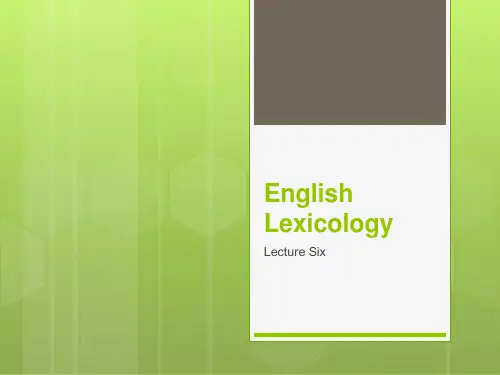
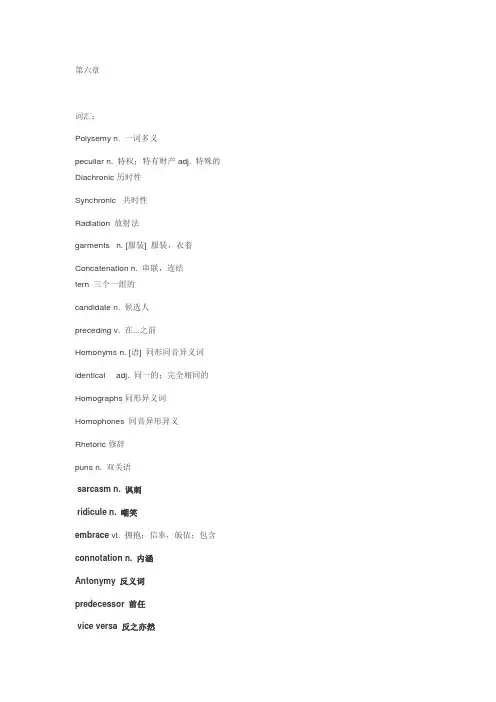
第六章词汇:Polysemy n. 一词多义peculiar n. 特权;特有财产adj. 特殊的Diachronic 历时性Synchronic 共时性Radiation 放射法garments n. [服装] 服装,衣着Concatenation n. 串联,连结tern 三个一组的candidate n. 候选人preceding v. 在...之前Homonyms n. [语] 同形同音异义词identical adj. 同一的;完全相同的Homographs同形异义词Homophones 同音异形异义Rhetoric 修辞puns n. 双关语sarcasm n. 讽刺ridicule n. 嘲笑embrace vt. 拥抱;信奉,皈依;包含connotation n. 内涵Antonymy 反义词predecessor 前任vice versa 反之亦然Hyponymy 上下位关系要点一. 1.Polysemy—polysemy is a common feature peculiar to all natural languages. When a words is first coined, it always monosemic, butin the course of development , the same word may have two or more different meanings.e.g. The word "flight" may mean "passing through the air", "power of flying", "air of journey", etc.2.Two approaches1).( Diachronic approach –Diachronically, polysemy is assumed to be the result of growth and development ofthe semantic structure of one and same word.This first meaning is the primary meaning. With the advance of timeand the development of language, it took on more and more meanings. These latter meanings are called derived meanings.E.g. faceThe primary meaning gave birth to new meaning.The primary meaning become either absolute or disappeared altogetherE.g. harvesttime of cutting reaping and gathering the cropsa season‘s yield of grain or fruitPain penalty or punishment pains and penaltyupon/under pain of suffering2).Synchronic approach –synchronically, polysemy is viewed as the coexistent of various meaning of the same word in a certain historical period of time.The basic meaning of a word is the core of word meaning.The core of word meaning called the central meaning (secondary meaning).The central meaning has gradually dimished in currency with the changes and one ofthe derived meanings has become dominant.E.g. gay3.Two process of development1). Radiation-a semantic process which shows that the primary meaning stands at the center and each of the derived meanings proceed out of in every direction like rays.The meanings are independent of one another, but can all be tracked back to thecentral meaning.e.g. Neck1) That part of a man or animal jointing the head to the body2) That part of the garments3) The neck of an animal used as food4) A narrow part between the head and body or base of any object5) The part of anythingOf the 5 meanings 1) is the primary and all the rest are derived but each of the otherfour is directly related to 1).Therefore, we say neck has developed through the process of radiation.2).Concatenation –meaning ―linking together, is the semantic process in which the meaning of a word moves gradually away from its first sense by successive shifts until,in many cases, there is not a sign of connectionbetween the sense that is finally developed and that which the term hadat the begining.e.g. candidate1) White-robed adj. 穿白色长袍的2) Office seeker in white gouns3) A person who seeks an office4) A person proposed for a place, award, etc.Of the 4 meanings, 1) is the primary meaning and the other three are derived, but each of the derived meaning isonly directly related to the preceding one and there is no direct connection between 1) and 4). Therefore, we saycandidate has developed through the process of concatenation.3).DifferenceRadiation and concatenation is closely related, being different stages of thedevelopment leading to polysemy.Radiation, each of the derived meaning is directly connected to the primary meaning.Concatenation, each of the later meaning is related only to the preceding one likechains. Though the latest sensecan be tracked to the original, there‘s no direct connection in between.The two processes work together, complementing each other.Radiation precedes concatenation.1.Homonyms--are generally defined as words different in meaning but either identical both i n s ound and spellingor identical only in sound or spelling.2.1).Perfect Homonyms--are words identical both in sound and spelling, but different in meaning.e.g. bank/bank ,bear/bear ,date/date2).Homographs--are words identical only in spelling but different in sound and meaning.e.g. Bow/bow ,Sow/sow3).Homophones (most common)--are words identical only in sound but different in spelling a nd meaning.e.g. Dear/dear ,Right/rite ,Son/sun3.Origins of Homonyms1). Change in sound and spelling(homonyms are native by origin, derived from different earlier forms in OldEnglish. The change in sound and spelling gradually made them identical in modernEnglish.)e.g. ear/ear ,long/long2). Borrowing (many words of foreign origin coincide in sound and/or spelling withthose of native origin with those of other foreign origin.)e.g. fair/fair,ball/ball3). Shortening (many shortened forms of words happen to be identical with otherwords in spelling or sound)e.g. ad/add,rock/rock ,NOW/now4.Differentiation of Homonyms and polysemants(Perfect homonyms and polysemants are fully identical regard to spelling and pronunciation. )Homonyms refer to different word, which happen to share the same forms.Polysemant is the one and some word, which has several meanings.1).One important criterion is to see their etymology. Homonyms are from differen tsources. A polysemant is from the same source,which has acquired different meaning in the course of development.2). The second principle is semantic relatedness.The various meanings of a polysemant are correlated andconnected to some central meaning to a greater or less degree. Meanings of different homon yms have nothing to do with one another.5.Rhetoric featureThey create puns for desired effect of, say, humour, sarcasm or ridicule.三.1.Synonyms—are words different in sound and spelling but most nearly alike or exactly the same in mean ing.Synonyms share a likeness in denotation and in part of speech.2.Types of Synonyms1).Absolute (Complete) Synonyms--are words, which are identical in meaning inall its aspects, both in grammatical meaning and lexical meaning,including c onceptual and associative meanings.Absolute (Complete) Synonyms are restricted to high-specialized vocabulary.For instance, composition / compounding. They have the perfect same meaningin Lexicology.2).Relative (Near) synonyms--are similar or nearly the same in denotation but embrace different shades of meaning or different degrees of a given quality.e.g. Change/alter/varyTake stagger/reel/totter for example.Stagger implies unsteady movement characterized by a loss of balance and failure to maintai n a fixed course.E.g. stagger under a heavy load;Reel suggests a swaying or lurching so as to appear on the verge of falling.E.g. The drunken man reeled down the hall;Totter indicates the uncertain, faltering steps of a feeble old person or of an infant learning to walk.3.Sources of Synonyms1).Borrowing: (the most important source)2).Dialects and regional English:eg.Railway (BrE) railroad (AmE)Mother (BrE) minny (ScotE)Charm (BrE) glamour (ScotE)Ranch (AmE) run (AusE)Job (StandE) gig (BlackE)Jim (BlachE) mal person (StandE)3).Figurative a. 比喻的,象征的and euphemistic a.委婉的use of words:Occupation walk of life (fig.)Dreamer star-gazer (fig.)Drunk elevated (euph.)Lie distort the fact (euph.)4).Coincidence with idiomatic expressions:Win gain the upper handDecide make up one‘s mindFinish get throughHesitate be in two mindsHelp lend one a hand4.Discrimination of Synonyms1) Difference in denotation: differ in the range and intensity of meaning.Range (some words have a wider range of meaning than others)e.g. timid--timorousTimid is applied to the state of minds in which a person may happen to be at the moment, ant to the habitual disposition.Timorous is only to the disposition.Comprehend/ understandextend—increase—expandThe owner of the restaurant is going to extend the kitchen by ten feet this year. The company has decided to increase its sales by ten percent next year.The metal will expand if heated.Extent increase expand Differ in degree of intensitye.g. wealth—richThe wealth person is to posses more money and property than a rich man.work – toilWork is a general term having no special implications as ‗light‘ or ‗heavy‘, and‗mental‘ or ‗physical‘.Toil suggests ‗heavy and tiring work‘, associated with more with manual thanmental labor.want—wish—desireWant is the most general and has the widest range of meaning.Wish and desire are much narrow in sense2) Difference in connotation: differ in the stylistic and emotive coloring.Some words share the same denotation but differ in their stylistic appropriateness.E.g. The words borrowed from French and Latin are more formal than native words.These borrowings are more appropriate formal and technical writing.policeman – constable – bobby – coppoliceman(neutral) – constable(neutral) – bobby(colloquial) – cop(slangy)ask -- beg -- requestask (neutral); beg (colloquial); request (formal)archaic and poetic, which are self-suggestive.e.g.ire/anger,bliss/happiness,forlorn/distressed,dire/dreadful,list/listen,enow/enough,save/exp ect,mere/lake andsuch like are all synonyms, but in each the second is standard in usage whereas the first on e is old-fashioned and archaic, only found in poetry, earlier writing, etc.Many synonyms have clear affective valuesresult – consequence result(neutral ) – consequence(negative implication)big –greatbig(the bigness of size, volume and so on, without any emotive coloring) -great(suggest distinguished, eminent, outstanding)little – small – tinylittle (attractiveness, pleasantness)– small(not big),tiny(abnormal growth of the child)3) Difference in application: differ in usage.Many words are synonyms in meaning but different in usage in simple terms.They form different collocations and fit into different sentence patterns.E.g. allow – letallow sb to so sth. – let sb. do sth.answer – replyanswer(transitive v.) the letter – reply(intransitive v.) to the lettersense –meaningHe is a man of sense.empty -- vacantempty box/street/room (no one or nothing inside) vacant seat/chair/apartment(not occupied) lump –slice – chunk – sheet –cakea lump sugar– a slice of meat – a chunk of wood – a sheet of paper –a cake of soap四.1.Antonymy--is concerned with semantic opposition.Antonyms--are words which are opposite in meaning.2.Types of Antonyms (according to the semantic opposition )1) Contradictory terms –these antonyms are truly represent oppositeness of meaning. They are so opposed toeach other that they are mutually exclusive and admit no possibility between them.They assertion of one is the denial of the other.E.g. alive—dead, present--absent, male – female, boy – girl, true – false,same – different, imperfect –perfectSuch antonyms are non gradable.They can not be used in comparative degrees and do not allow adverbs like―very to qualify them. (single/married)特点:对立的/不可分级2) Contrary terms- a scale running between two poles or extremes. The two opposites are gra dable and one exists in comparison with the other.E.g. rich--(well-to-do)--poor; old –(middle-aged)-- young,open –(ajar)—close,beautiful –(good-looking) –(plain) –ugly,hot--(warm, cool)--coldverbs. E.g. love – (attachment) – (liking) – (indifferent) –(antipathy) -- hate3) Relative terms–consist of relational oppositeness. The pairs of words indicate such a socialrelationship that one of them can not be used without suggesting the other,the type is also reverse terms. The two words of each pair interdependent.E.g. parent--child; husband--wife; predecessor –successor, employer -- employee sell—buy, give –receive3.difference between relative terms and contradictory termsthere is an absolute opposite between relative terms and contradictory terms. In the case of relative terms, the opposition is only relational.contradictory terms –e.g. if the adult is not a man, then the adult must be a woman.4.the characteristics of antonyms1). Antonyms are classified on the basis of semantic opposition.形容词(most) -- 动词–名词(least)There are a great many more synonyms than antonyms.Words denoting nature, quality or state of things have many antonyms. This accounts for the large number of antonyms are adjectives.2). A word which has more than one meaning can have more than one antonym.e.g. fast – firm/secure loose quick slowpleasure-seeking/wild soberdull -- boring interestingShe became dull and silent during the last part of the journey.lively dull weather sunny ,dull noise sharp,dull pain acutethese factors affect both intelligent and dull children. Intelligent3).Antonyms differ in semantic inclusion.Pairs of antonyms are seen as marked and unmarked terms. One member is morespecific than the other and the meaning of the specific is included in that of the general.e.g. man–womanThere has been no man in the island. (man signifies human being, including women, but not v ice versa).dog-male/ female dogtall—shortHow tall is his brother? (includes the meaning of next one)How short is his brother? (more restricted in sense)4). Contrary terms are gradable antonyms, differing in degree of intensity, so each hasits own corresponding opposition.e.g. hot – cold, warm – cool, rich – poor, destitute – opulentSome words can have two different types of antonyms at the same time, one being negative and the other opposite.e.g. happy—unhappy-sad,productive—unproductive—destructivefree--unfree-enslaved5.the use of antonymsAntonyms have various practical uses and have long proved helpful and valuable indefining the meanings of words.fresh bread –stale bread, fresh air –stuff air, fresh flower -faded flower,fresh look – tired lookAntonyms are useful to express economically the opposition of a particular thought,often for the sake for contrast. They look neat and pleasan t, and sound rhythmicMany idioms are formed with antonyms.Rain and shine无论如何Here and there到处Weal and woe祸福Friend and foe敌友Now or never机不可失Thick and thin不顾艰难,险阻High and low到处Give an take互让,平等Antonyms are often used to form antithesis to achieve emphasis by puttingcontrasting idea together.Easy come, easy go. 来的易,去得快。
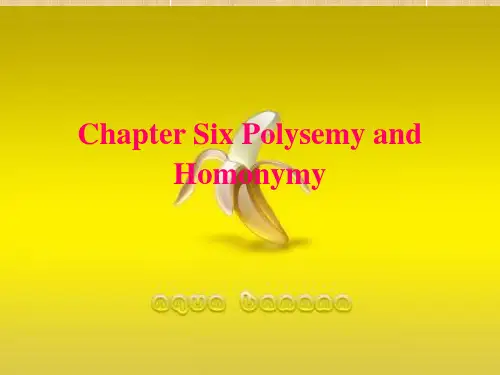
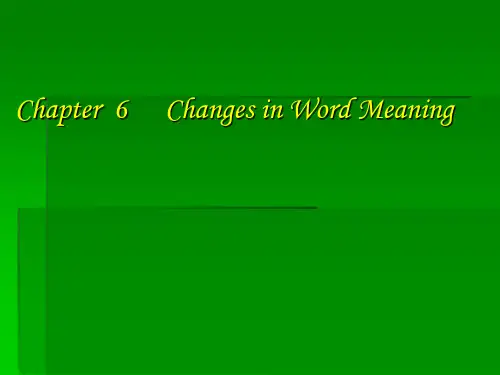
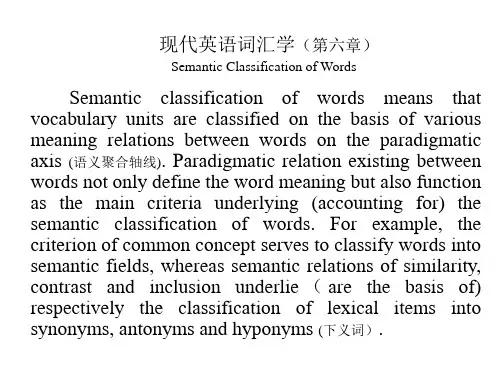
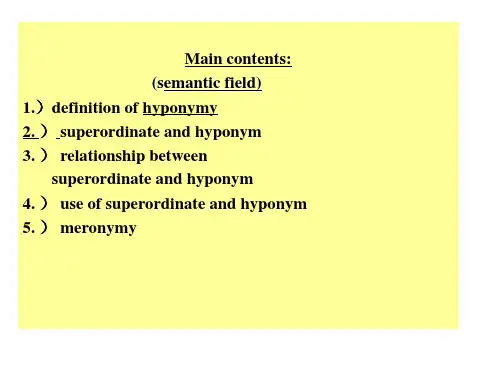
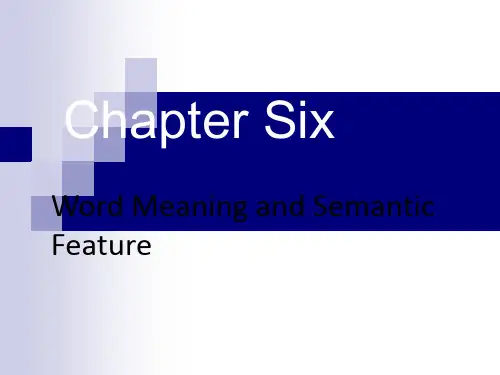
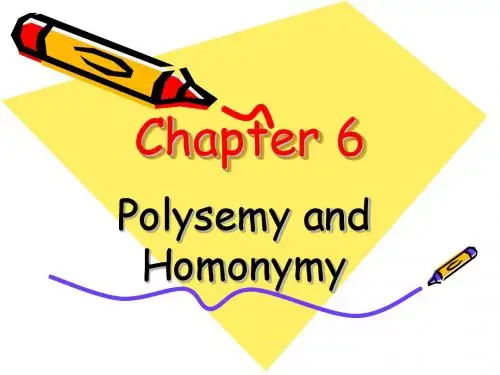
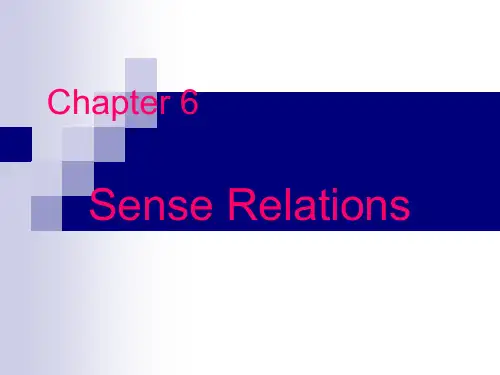

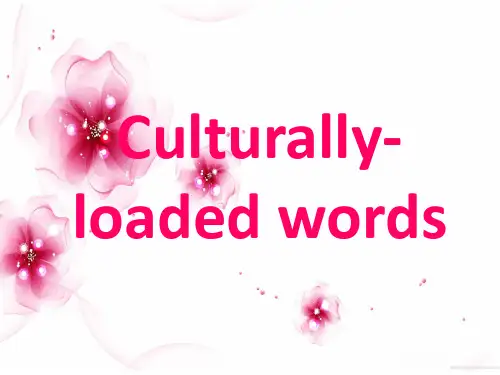
第六章词汇:Polysemy n. 一词多义peculiar n. 特权;特有财产adj. 特殊的Diachronic 历时性Synchronic 共时性Radiation 放射法garments n. [服装] 服装,衣着Concatenation n. 串联,连结tern 三个一组的candidate n. 候选人preceding v. 在...之前Homonyms n. [语] 同形同音异义词identical adj. 同一的;完全相同的Homographs同形异义词Homophones 同音异形异义Rhetoric 修辞puns n. 双关语sarcasm n. 讽刺ridicule n. 嘲笑embrace vt. 拥抱;信奉,皈依;包含connotation n. 内涵Antonymy 反义词predecessor 前任vice versa 反之亦然Hyponymy 上下位关系要点一. 1.Polysemy—polysemy is a common feature peculiar to all natural languages. When a words is first coined, it always monosemic, butin the course of development , the same word may have two or more different meanings.e.g. The word "flight" may mean "passing through the air", "power of flying", "air of journey", etc.2.Two approaches1).( Diachronic approach –Diachronically, polysemy is assumed to be the result of growth and development ofthe semantic structure of one and same word.This first meaning is the primary meaning. With the advance of timeand the development of language, it took on more and more meanings. These latter meanings are called derived meanings.E.g. faceThe primary meaning gave birth to new meaning.The primary meaning become either absolute or disappeared altogetherE.g. harvesttime of cutting reaping and gathering the cropsa season‘s yield of grain or fruitPain penalty or punishment pains and penaltyupon/under pain of suffering2).Synchronic approach –synchronically, polysemy is viewed as the coexistent of various meaning of the same word in a certain historical period of time.The basic meaning of a word is the core of word meaning.The core of word meaning called the central meaning (secondary meaning).The central meaning has gradually dimished in currency with the changes and one ofthe derived meanings has become dominant.E.g. gay3.Two process of development1). Radiation-a semantic process which shows that the primary meaning stands at the center and each of the derived meanings proceed out of in every direction like rays.The meanings are independent of one another, but can all be tracked back to thecentral meaning.e.g. Neck1) That part of a man or animal jointing the head to the body2) That part of the garments3) The neck of an animal used as food4) A narrow part between the head and body or base of any object5) The part of anythingOf the 5 meanings 1) is the primary and all the rest are derived but each of the otherfour is directly related to 1).Therefore, we say neck has developed through the process of radiation.2).Concatenation –meaning ―linking together, is the semantic process in which the meaning of a word moves gradually away from its first sense by successive shifts until,in many cases, there is not a sign of connectionbetween the sense that is finally developed and that which the term hadat the begining.e.g. candidate1) White-robed adj. 穿白色长袍的2) Office seeker in white gouns3) A person who seeks an office4) A person proposed for a place, award, etc.Of the 4 meanings, 1) is the primary meaning and the other three are derived, but each of the derived meaning isonly directly related to the preceding one and there is no direct connection between 1) and 4). Therefore, we saycandidate has developed through the process of concatenation.3).DifferenceRadiation and concatenation is closely related, being different stages of thedevelopment leading to polysemy.Radiation, each of the derived meaning is directly connected to the primary meaning.Concatenation, each of the later meaning is related only to the preceding one likechains. Though the latest sensecan be tracked to the original, there‘s no direct connection in between.The two processes work together, complementing each other.Radiation precedes concatenation.1.Homonyms--are generally defined as words different in meaning but either identical both i n s ound and spellingor identical only in sound or spelling.2.1).Perfect Homonyms--are words identical both in sound and spelling, but different in meaning.e.g. bank/bank ,bear/bear ,date/date2).Homographs--are words identical only in spelling but different in sound and meaning.e.g. Bow/bow ,Sow/sow3).Homophones (most common)--are words identical only in sound but different in spelling a nd meaning.e.g. Dear/dear ,Right/rite ,Son/sun3.Origins of Homonyms1). Change in sound and spelling(homonyms are native by origin, derived from different earlier forms in OldEnglish. The change in sound and spelling gradually made them identical in modernEnglish.)e.g. ear/ear ,long/long2). Borrowing (many words of foreign origin coincide in sound and/or spelling withthose of native origin with those of other foreign origin.)e.g. fair/fair,ball/ball3). Shortening (many shortened forms of words happen to be identical with otherwords in spelling or sound)e.g. ad/add,rock/rock ,NOW/now4.Differentiation of Homonyms and polysemants(Perfect homonyms and polysemants are fully identical regard to spelling and pronunciation. )Homonyms refer to different word, which happen to share the same forms.Polysemant is the one and some word, which has several meanings.1).One important criterion is to see their etymology. Homonyms are from differen tsources. A polysemant is from the same source,which has acquired different meaning in the course of development.2). The second principle is semantic relatedness.The various meanings of a polysemant are correlated andconnected to some central meaning to a greater or less degree. Meanings of different homon yms have nothing to do with one another.5.Rhetoric featureThey create puns for desired effect of, say, humour, sarcasm or ridicule.三.1.Synonyms—are words different in sound and spelling but most nearly alike or exactly the same in mean ing.Synonyms share a likeness in denotation and in part of speech.2.Types of Synonyms1).Absolute (Complete) Synonyms--are words, which are identical in meaning inall its aspects, both in grammatical meaning and lexical meaning,including c onceptual and associative meanings.Absolute (Complete) Synonyms are restricted to high-specialized vocabulary.For instance, composition / compounding. They have the perfect same meaningin Lexicology.2).Relative (Near) synonyms--are similar or nearly the same in denotation but embrace different shades of meaning or different degrees of a given quality.e.g. Change/alter/varyTake stagger/reel/totter for example.Stagger implies unsteady movement characterized by a loss of balance and failure to maintai n a fixed course.E.g. stagger under a heavy load;Reel suggests a swaying or lurching so as to appear on the verge of falling.E.g. The drunken man reeled down the hall;Totter indicates the uncertain, faltering steps of a feeble old person or of an infant learning to walk.3.Sources of Synonyms1).Borrowing: (the most important source)2).Dialects and regional English:eg.Railway (BrE) railroad (AmE)Mother (BrE) minny (ScotE)Charm (BrE) glamour (ScotE)Ranch (AmE) run (AusE)Job (StandE) gig (BlackE)Jim (BlachE) mal person (StandE)3).Figurative a. 比喻的,象征的and euphemistic a.委婉的use of words:Occupation walk of life (fig.)Dreamer star-gazer (fig.)Drunk elevated (euph.)Lie distort the fact (euph.)4).Coincidence with idiomatic expressions:Win gain the upper handDecide make up one‘s mindFinish get throughHesitate be in two mindsHelp lend one a hand4.Discrimination of Synonyms1) Difference in denotation: differ in the range and intensity of meaning.Range (some words have a wider range of meaning than others)e.g. timid--timorousTimid is applied to the state of minds in which a person may happen to be at the moment, ant to the habitual disposition.Timorous is only to the disposition.Comprehend/ understandextend—increase—expandThe owner of the restaurant is going to extend the kitchen by ten feet this year. The company has decided to increase its sales by ten percent next year.The metal will expand if heated.Extent increase expand Differ in degree of intensitye.g. wealth—richThe wealth person is to posses more money and property than a rich man.work – toilWork is a general term having no special implications as ‗light‘ or ‗heavy‘, and‗mental‘ or ‗physical‘.Toil suggests ‗heavy and tiring work‘, associated with more with manual thanmental labor.want—wish—desireWant is the most general and has the widest range of meaning.Wish and desire are much narrow in sense2) Difference in connotation: differ in the stylistic and emotive coloring.Some words share the same denotation but differ in their stylistic appropriateness.E.g. The words borrowed from French and Latin are more formal than native words.These borrowings are more appropriate formal and technical writing.policeman – constable – bobby – coppoliceman(neutral) – constable(neutral) – bobby(colloquial) – cop(slangy)ask -- beg -- requestask (neutral); beg (colloquial); request (formal)archaic and poetic, which are self-suggestive.e.g.ire/anger,bliss/happiness,forlorn/distressed,dire/dreadful,list/listen,enow/enough,save/exp ect,mere/lake andsuch like are all synonyms, but in each the second is standard in usage whereas the first on e is old-fashioned and archaic, only found in poetry, earlier writing, etc.Many synonyms have clear affective valuesresult – consequence result(neutral ) – consequence(negative implication)big –greatbig(the bigness of size, volume and so on, without any emotive coloring) -great(suggest distinguished, eminent, outstanding)little – small – tinylittle (attractiveness, pleasantness)– small(not big),tiny(abnormal growth of the child)3) Difference in application: differ in usage.Many words are synonyms in meaning but different in usage in simple terms.They form different collocations and fit into different sentence patterns.E.g. allow – letallow sb to so sth. – let sb. do sth.answer – replyanswer(transitive v.) the letter – reply(intransitive v.) to the lettersense –meaningHe is a man of sense.empty -- vacantempty box/street/room (no one or nothing inside) vacant seat/chair/apartment(not occupied) lump –slice – chunk – sheet –cakea lump sugar– a slice of meat – a chunk of wood – a sheet of paper –a cake of soap四.1.Antonymy--is concerned with semantic opposition.Antonyms--are words which are opposite in meaning.2.Types of Antonyms (according to the semantic opposition )1) Contradictory terms –these antonyms are truly represent oppositeness of meaning. They are so opposed toeach other that they are mutually exclusive and admit no possibility between them.They assertion of one is the denial of the other.E.g. alive—dead, present--absent, male – female, boy – girl, true – false,same – different, imperfect –perfectSuch antonyms are non gradable.They can not be used in comparative degrees and do not allow adverbs like―very to qualify them. (single/married)特点:对立的/不可分级2) Contrary terms- a scale running between two poles or extremes. The two opposites are gra dable and one exists in comparison with the other.E.g. rich--(well-to-do)--poor; old –(middle-aged)-- young,open –(ajar)—close,beautiful –(good-looking) –(plain) –ugly,hot--(warm, cool)--coldverbs. E.g. love – (attachment) – (liking) – (indifferent) –(antipathy) -- hate3) Relative terms–consist of relational oppositeness. The pairs of words indicate such a socialrelationship that one of them can not be used without suggesting the other,the type is also reverse terms. The two words of each pair interdependent.E.g. parent--child; husband--wife; predecessor –successor, employer -- employee sell—buy, give –receive3.difference between relative terms and contradictory termsthere is an absolute opposite between relative terms and contradictory terms. In the case of relative terms, the opposition is only relational.contradictory terms –e.g. if the adult is not a man, then the adult must be a woman.4.the characteristics of antonyms1). Antonyms are classified on the basis of semantic opposition.形容词(most) -- 动词–名词(least)There are a great many more synonyms than antonyms.Words denoting nature, quality or state of things have many antonyms. This accounts for the large number of antonyms are adjectives.2). A word which has more than one meaning can have more than one antonym.e.g. fast – firm/secure loose quick slowpleasure-seeking/wild soberdull -- boring interestingShe became dull and silent during the last part of the journey.lively dull weather sunny ,dull noise sharp,dull pain acutethese factors affect both intelligent and dull children. Intelligent3).Antonyms differ in semantic inclusion.Pairs of antonyms are seen as marked and unmarked terms. One member is morespecific than the other and the meaning of the specific is included in that of the general.e.g. man–womanThere has been no man in the island. (man signifies human being, including women, but not v ice versa).dog-male/ female dogtall—shortHow tall is his brother? (includes the meaning of next one)How short is his brother? (more restricted in sense)4). Contrary terms are gradable antonyms, differing in degree of intensity, so each hasits own corresponding opposition.e.g. hot – cold, warm – cool, rich – poor, destitute – opulentSome words can have two different types of antonyms at the same time, one being negative and the other opposite.e.g. happy—unhappy-sad,productive—unproductive—destructivefree--unfree-enslaved5.the use of antonymsAntonyms have various practical uses and have long proved helpful and valuable indefining the meanings of words.fresh bread –stale bread, fresh air –stuff air, fresh flower -faded flower,fresh look – tired lookAntonyms are useful to express economically the opposition of a particular thought,often for the sake for contrast. They look neat and pleasan t, and sound rhythmicMany idioms are formed with antonyms.Rain and shine无论如何Here and there到处Weal and woe祸福Friend and foe敌友Now or never机不可失Thick and thin不顾艰难,险阻High and low到处Give an take互让,平等Antonyms are often used to form antithesis to achieve emphasis by puttingcontrasting idea together.Easy come, easy go. 来的易,去得快。
C6 Test-1I. Each of the statements below is followed by four alterna-tive answers. Choose the one that would best complete the state-ment.1. Sense relations include .A. polysemy, analogy, amelioration, homonymy and hyponymyB. tautology, analogy, synonymy, antonymy and homonymyC. polysemy, homonymy, synonymy, antonymy and hyponymyD. inconsistency, homonymy, synonymy, antonymy and hypon-ymy2. is a common feature peculiar to all natural languag-es because overwhelming majority of words have more than one meaning.A. PolysemyB. HyponymyC. SynonymyD. Homonymy3. The two approaches to polysemy are approach and approach.A. syntagmatic, paradigmaticB. diachronic, synchronicC. dichronic, syntagmaticD. synchronic, paradigmatic4. At the time when the word was created, it was endowed with only one meaning. This first meaning is the mean-ing.A. associativeB. stylisticC. primaryD. affective5. The later meanings added to the first meaning of the word are calledmeanings.A. lexicalB. conceptualC. secondaryD. derived6. Synchronically, the basic meaning of a word is the core of word meaning called the meaning.A. primaryB. secondaryC. centralD. derived7. The development of word meaning from monosemy to polysemy follows two courses, traditionally called and .A. elevation, degradationB. extension, narrowingC. radiation, concatenationD. radiation, extension8. Radiation is a semantic process in which the mean-ing stands at the center and the meanings proceed out of it in every direction like rays.A. secondary, primaryB. primary, secondaryC. conceptual, associativeD. lexical, grammatical9. In the derived meanings are directly connected to the meaning.A. concatenation, centralB. radiation, primaryC. radiation, secondaryD. concatenation, associative10. Generally, precedes .A. concatenation, radiationB. widening, concatenationC. narrowing, wideningD. radiation, concatenation11. are words different in meaning but either identical both in sound and spelling or identical only in sound or spelling.A. HomographsB. HomonymsC. Perfect homonymsD. Homophones12. Perfect homonyms are .A. homographsB. both homophones and homographsC. homophonesD. identical both in sound and spelling, but different in meaning13. All of the following are the sources of homonyms except .A. change in sound and spellingB. shorteningC. borrowingD. extension14. The sources of English synonyms exclude .A. dialects and regional EnglishB. figurative and euphemistic use of wordsC. extension, narrowing, elevation and degradation of wordsD. coincidence with idiomatic expressions15. The differences between synonyms boil down to three areas:.A. elevation, connotation, applicationB. connotation, elevation, degradationC. connotation, denotation, applicationD. amelioration, deterioration, denotation16. By connotation we mean the and co-louring of words.A. derogatory, commendatoryB. stylistic, emotiveC. rhetoric, semanticD. emotive, collocative17. “lump”, “slice”, “chunk”, “sheet” and “cake” have the same meaning, “piece”, but they are different in .A. conceptual, connotationB. lexical, denotationC. conceptual, applicationD. associative, collocation18. The two features of contradictory terms are and .A. mutually exclusive, non-gradableB. inclusive, exchangeableC. relative, interdependentD. relational, interdependent19. “east/west” are.A. contrary termsB. contradictory termsC. relative termsD. co-hyponyms20. People use antonyms in idioms to .A. express ideas economically for the sake of contrastB. form antithesis to achieve emphasisC. both A and BD. reach climax21. Contrary terms are gradable antonyms, differing in degree of .A. formalityB. rhetoric colouringC. assimilationD. intensity22. “hate/love” are.A. contrary termsB. contradictory termsC. relative termsD. complementary antonyms23. Least antonyms are found among nouns which are names of .A. objectsB. ideasC. domainsD. all the above24. “compounding” and “composition” are.A. absolute synonymsB. relative synonymsC. stylistic synonymsD. emotive synonyms25. Homonyms, particularly, are often employed to create for desired effect of, say, humour, sarcasm or ridicule.A. homographs, punsB. homophones, antithesisC. homophones, punsD. homographs, antithesis26. When a word is first coined, it is always .A. monosemicB. polysemicC. neutralD. informal27. A/an has more semantic: components than a/an .A. superordinate term, subordinate termB. subordinate term, superordinate termC. grammatical wont, lexical wordD. native wonl, loan word28.“teacher” anti “student” are.A. relative termsB. contrary termsC. contradictoryD. superordinates29. “piglet ”, “chicken”, “child” and “duckling” share the same semantic component.A. animalB. adultC. maleD. young30. A/an is general and a/an is specific.A. hyponym, subordinate termB. superordinate, subordinate termC. polysemant, monosemantD. lower term, upper term31. The differences between synonyms lie in three aspects except .A. grammatical meaningB. applicationC. connotationD. denotation32. “widow/widower” are.A. eontradictory antonymsB. relative antonymsC. contrary antonymsD. not antonyms33. Absolute synonyms are .A. numerousB. rareC. popularD. common34. Associative meaning comprises several types except .A. connotative meaningB. stylistic meaningC. affective meaningD. lexieal meaning35. Homonyms are generally words different in but ei-ther identical both in oridentical only in .A. sound; meaning and spelling; meaning or spellingB. meaning; sound and spelling; sound or spellingC. spelling; meaning and sound; sound or spellingD. meaning; sound and spelling; sound36. Relative synonyms also called near-synonyms are similar or nearly the same in.A. affective meaningB. conceptual meaningC. eollocative meaningD. stylistic meaning37. The origins of homonyms are .A. change in soundB. shorteningC. borrowingD. all the above38. In concatenation, between the latest sense and the original sense, there is in many cases.A. a sign of connection between themB. some signs of connection between themC. not a sign of connection between themD. many signs of connection between them39. In diachronic approach, other meanings apart from the pri-mary meaning of a word were acquired by .A. extension and transferB. narrowingC. analogyD. all the above40. The most important sources of synonyms is perhaps .A. dialects and regional EnglishB. borrowingC. figurative and euphemistic use of wordsD. eoincidence with idiomatic expressionsII. Complete the following statements with proper words or expressions according to the course book.1. “some” and “sum” are.2. “date” and “date” are identical both in sound and spelling, but differ in meaning .They are .3. From the point of view, polysemy is assumed to be the result of growth and development of the semantic structure of the one and same word.4. Synonyms share a likeness in as well as in part of speech.5. The development of word meaning from monosemy to polysemy follows two courses, traditionally known as radiation and .6. Perfect homonyms and polysemants are fully identical with re-gard to spelling and .7. Synchronically, polyscmy is viewed as the of various meanings of the same word in a certain historical period of time.8. Synonyms can be classified into two major types: absolute syn-onyms andsynonyms.9.The original meaning of “pain” was “”.10.When a word is first coined, it is always .11. Words are arbitrary symbols and are independent entities so far as their outer facet——spelling and , is concerned.12. Diachronically, the meanings of a polysemant include a pti-mary meaning andmeanings.13. Synchronically, the meanings of a polysemant include a cen-tral meaning andmeanings.14.Concatenation describes a process where each of the later meanings is related only to the preceding one like .15. Homophones and homographs are homonyms.16. Of perfect homonyms, homographs and homophones, constitute the largest number and are most common.17. Synonyms are the words which have the same or very nearly the samemeaning.18. Relative synonyms are different in denotation, and application.19. Synonyms can be defined as words different in sound and but most nearly alike or exactly the same in meaning.20. Difference in connotation between synonyms refers to the dif-ference inand emotive colouring of words.21. “policeman” and “constable” are stylistically , yet the former is used both in British English and Ameri-can English while the latter is only in British English.22.“big” is generally used to show the bigness of size, volume, extent, weight, number, and so on, any emotive colouring.23. Contrary terms are antonyms, differing in degree of intensity, so each has its own corresponding opposite.24. In each pair of contradictory terms, the of one is the denial of the other.25. Contrary terms are best viewed in terms of a scale running be-tween two poles or .26. With regard to contrary terms, the two opposites are gradable and one existsthe other.27. There is a/an opposition between contradictory terms.28. In the case of relative terms, the opposition is only .29. Semantic is one characteristic of contrary terms.30. Words denoting nature, quality or state of things have many antonyms. This accounts for the large number of antonyms among .31 .The hyponyms under the same superordinate are .32. On the basis of opposition, antonyms are classified into contradictory terms, contrary terms and relative terms.33. “donor/recipient” and “boss/employee” are all terms.34. Words of language can be classified into semantically sets or .35 .The semantic field of the same may not have the same members in different languages.36. “empty” and “vacant” are synonyms, but they are different in .37. Absolute synonyms are in every way.38. Absolute synonyms are restricted to highly vocabu-lary.39. Homonyms are different from polysemants in etymology and .40. Absolute synonyms are identical in grammatical meaning and lexical meaning, including conceptual meaning and mean-ing.III. Match the words or expressions in Column A with those in Column B according to①types of synonyms;②types of ant-onyms;③types of homonyms;④hyponymy and ⑤sources of syn-onyms.A B1. upstairs/downstairs A. contradictory terms2. mango/fruit B. homophones3. brother/bug C. stationery/hyponyms4. cellar/attic D. emotive synonyms/synonymsdiffering in emotive values5.stay/leave E. collocative synonyms/synonyms differing in applica-tion/co]location6. leek/leak F. homographs7. pasty (adj)/pasty (n) G. regional/dialectal symonyms8. fair(n)/fair(adj ) H. reversives9. pen, ruler, eraser I. relative terms10. siren/beautiful J. upper term/lower term11. scarlatina/scarlet fever K. stylistic synonyms/synonyms differing in style12. persist/insist L. borrowing13. sidewalk/pavement M. perfect homonyms14. creature/animal N. subordinate/superordinate15. improve/deteriorate O.synonyms differing in denotation16. timid/timorous P. contrary terms17.work of life (occupation) Q.euphemistic use of words18. hesitate/be in two minds R. absolute synonyms19. elevated (: drunk) S. coincidence with idiomatic ex-pressions20. chamber( = room) T. figurative use of wordsIV. Study the following words or expressions and identify ①types of synonyms; ②types of antonyms; ③types of homonyms;④hyponymy; ⑤sources of synonyms and ⑥origins of horn-onyms.1. long(from lang)/long (from langian) ( )2. write/rite ( )3. stagger/reel/totter ( )4. sow(n. )/sow(v. ) ( )5. ball(OE)/ball(OF) ( )6. bear(n. )/bear(v. ) ( )7.rock (from rock …n‟roll)/rock ( )8. dire/dreadful ( )9. result/consequence ( )10. empty/vacant/blank ( )11. railway/railroad ( )12. star-gazer( = dreamer) ( )13. boyfriend/girlfriend ( )14. charge/pay ( )15. tree/elm ( )16. hit/miss ( )17.disort the fact(=lie) ( )18. trepidation( = fear) ( )19. hound/dog ( )20. help/lend one a hand ( )21. hood/hood(from hoodlum) ( )22. mean ( v )/mean (adj from French) ( )23. up/down ( )24. right/wrong ( )25. caecitis / typhlitis ( )26. false/true ( )27. rent/let ( )28. enemy/foe ( )29. flat/apartment ( )30. perfect/imperfect ( )31. accelerate/decelerate ( )32. lure/attract ( )33. ancestor/descendant ( )34. sound(n.)/sound(adj) ( )35. read/reed ( )36. minute(n.)/minute(adj) ( )37.beer, milk, soda ( )38. rich/wealthy ( )39. shut/open ( )40. little/small/tiny ( ) V. Define the following terms.1. sense relations2. polysemy3. diachronic approach4. primary meaning5. derived meaning6. synchronic approach7. central meaning8. secondary meaning9. radiation10. concatenation11. homonyms12. perfect homonyms13. homographs14. polysemant15. synonyms16. absolute/complete synonyms17. relative synonyms/near-synonyms18. antonyms19. contradictory terms20 contrary terms21. relative terms22. hyponymy23. hyponyms/subordinate terms/lower terms24. superordinate term/upper term25. co-hyponyms26. semantic fieldVI. Answer the following questions. Your answers should be clear and short. Write your answers in the space given.1. What are the reasons for polysemy?2.What arc the two approaches to polysemy?3. What are the two processes of development of polysemy? What are their features?4. What are the differences between radiation and concatenation?5. How are homonyms classified7 What are their characteristics76. What are the origins of homonyms? How do they become hom-onyms?7. What are the differences between homonyms and polysemants?8. How do we classify synonyms? What are their characteristics?9. How many sources of synonyms are there.? What are they?10.How do you distinguish relative synonyms? What are their characteristics?11. How are antonyms classified?12. What are the characteristics of antonyms?13. What is the use of homonyms/What are the rhetorical features of homonyms?14. What are the characteristics of contradictory terms?15. What are the characteristics of contrary terms?16. What are the characteristics of relative terms?17. What is the use of antonyms?18. What is hyponymy? Use an example to illustrate it.19. What is semantic field? What are its characteristics?VI .Analyze and comment on the following. Write your an-swers in the space given below.1. (1) I met a scientist who is a relation of a journalist.A B C(2)I met a biologist who is a brother of a magazine reporter .A B CStudy the two sentences, and explained the relationship between each corresponding underlined parts in the two sentences. Which sen-tence is clearer.'? Why?2. A: S he can‟t bear children?B: What do you mean? Do you mean she can't give birth to babies?A: Not that ......Why can‟t speaker B understand what speaker A said? Ex-plain the reasons. Howcan speaker A put it clear?3. A: Look at the crane, John.B: What, mum?A: The crane.B: The crane? Where?A: There, in the field near the building, the thing with a long neck.B: Mum, is that a crane? It's quite different from the crane I saw the other day.Study the dialogue and explain why the two cranes are quite different in the minds of the two speakers.4. The word “treacle” meant “wild beast” as its primary meaning while its modern meaning is “molasses”. What process of development does it follow? Why? Then, list the processes of word-meaning devel-opment.5. lonely/solitaryWhat kind of synonymy do they belong to? What are the charac-teristics of this kind of synonymy? How are synonyms classified?6. (1)How young is he?(2)How old is he?Although the above two sentences are both grammatically right, sentence (1) is seldom used. Why? When is sentence ( 1 ) used?7. A fair lady's going to the fair to buy a square pear.What do the two "fairs" mean respectively?What kind of sense relation do they belong to?What type of that sense relation do they belong to?What are their origins?8. Penny wise, pound foolish.What antonyms do the two underlined words belong to ? Comment on the use of the pair in the idiom.答案:I. Each of the statements below is followed by four alternative answers. Choose the one that would best complete the statement.1.C2.A3.B4.C5.D6.C7.C8.B9.B10.D11.B 12.D 13.D 14.C15.C16.B 17.C 18.A 19.C20.C21 .D 22.A 23.D 24.A25.C26. A 27. B 28.A 29. D 30. B31 .A 32.A 33.B 34.D35.B36. B 37. D 38. C 39. D40. BII. Complete the following statements with proper words or expressions according to the course book.1. homophones2. perfect homonyms3. diachronic4. denotation5. concatenation6. pronunciation7. coexistence 8. relative9. penalty or punishment 10. monogenic11. pronunciation 12. derived13. secondary 14. chains15. partial/imperfect 16. homophones17. essential 18. connotation19. spelling 20. stylistic21. neutral 22. without23. gradable 24. assertion25. extremes 26. in comparison with27. absolutes 28. relational29. relativity 30. adjectives31. co-hyponyms 32. semantic33. relative 34. fields35. concept 36.application/collocation 37. interchangeable 38. specialized39. semantic relatedness 40. associativeIII. Match the words or expressions in Column A with those in Column B according to ①types of synonyms;②types of antonyms; ③types of homonyms; ④hyponymy and ⑤sources of synonyms.1. I2.N3.K4.P5.A6. B7.F8.M9.C 10.D11.R 12.E 13.G 14.J 15.H16.O 17.T 18.S 19.Q 20.LIV. Study the following words or expressions and identify ①types of synonyms; ②types of antonyms;③types of homonyms; ④hyponymy; ⑤sources of synonyms and ⑥origins of homonyms.1. chage in sound and spelling2. homophones3. synonyms differing in denotation ( 只答relative synonyms 或near-synonyms 给半分)4. homographs5. borrowing6. perfect homonyms7. shortening8. different in connotation/different in style9. different in connotation/different in emotive values10. different in application/collocation11. regional synonyms/dialectal synonyms12. figurative use of words13. relative terms14. relative terms15.general/ specific; superordinate / subordinate; upper term/lower term16. contradictory terms17. euphemistic use of words18. borrowing/formal19. hyponym/superordinate; subordinate/ superordinate; lower term/upper term; specific/general20. coincidence with idiomatic expressions21. shortening22. homophones23. relative terms24. contradictory terms25. perfect homonyms26. contradictory terms27. relative terms28. synonyms differing in style29. regional synonyms/dialectal synonyms30. contradictory antonyms31. relative terms32. synonyms differing in connotation/in emotive values33. relative synonyms 34. perfect homonyms35. homophones36. homographs37. co-hyponyms38. synonyms differing in denotation39. contrary terms40. synonyms differing in connotation in emotive (/affective) valuesV . Define the following terms.1. A word which is related to other words is related to them in sense, hence senserelations. They include polysemy, homonymy, synonymy, antonymy and hyponymy.2. Polysemy deals with words of two or more than two meanings.3. Diachronic approach studies the growth and development of the semantic structure of the one and same word.4. At the time when the word was created, it was endowed with only one meaning .This first meaning is the primary meaning.5. With the advance of time and the development of language, the word took on more and more meanings .These later meanings are called derived meanings as they are all derived from the primary meaning.6. Synchronic approach studies the coexistence of various meanings of the same word and how they are related to each other in a certain historical period of time.7. In synchronic study, the basic meaning, the core of word-meaning, is called the central meaning.8. In synchronic study, the meanings derived from the core of the word-meaning, or from the central meaning are called secondary meaning. Secondary meanings do not necessarily mean that they are secondary in importance. It only means that secondary meanings appear later than the central meaning.9. Radiation is a semantic process in which the primary meaning stands at the centre and the secondary meanings proceed out of it in every direction like rays. The meanings are independent of one another, but can all be traced back to the central meaning.10. Concatenation, meaning ' linking together', is the semantic process in which the meaning of a word moves gradually away from its first sense by successive shifts until, in many cases, there is not a sign of connection between the sense that is finally developed and that which the term had at the beginning. In plain terms the meaning reached by the first shift may be shifted a second time, and so on until in the end the original meaning is totally lost.11. Homonyms are generally defined as words different in meaning but either identical both in sound and spelling or identical only in sound or spelling.12. Perfect homonyms are words identical both in sound and spelling, butdifferent in meaning.13. Homographs are words identical only in spelling but different in sound and meaning.14. If a word has two or more than two meanings, the word is called a polysemant.15. Synonyms can be defined as words different in sound and spelling but most nearly alike or exactly the same in denotative meaning and share the same grammatical meaning.16. Absolute synonyms also known as complete synonyms are words identical in all aspects, i.e.both in grammatical meaning and lexical meaning, including conceptual and associative meanings. Synonyms of this type are interchangeable in every way.17 .Relative synonyms also called near-synonyms are similar or nearly the same in denotation, but embrace differentshades of meaning or different degrees of a given quality.18. Antonyms can be defined as words which are opposite in meaning.19. Contradictory terms truly represent oppositeness of meaning. They are so opposed to each other that they are mutually exclusive and admit no possibility between them. The assertion of one is the denial of the other.20. Contrary terms are best viewed in terms of a scale running between two poles or extremes. The two opposites are gradable and one exists in comparison with the other. They allow intermediate members.21 .Relative terms indicate such a reciprocal relationship that one of them cannot be used without suggesting the other.22. Hyponymy deals with the relationship of semantic inclusion. That is, the meaning of a more specific word is included in that of another more general word.23. Hyponymy deals with the relationship between a general word and a specific word. The specific words are called hyponyms, subordinate terms or lower terms.24. Hyponymy deals with the relationship between a general word and a specific word. The general word is called the superordinate term or the upper tern.25. Hyponymy deals with the relationship between a general word and a specific word. Usually a general word includes many specific words .The specific words under the same general word are called co-hyponyms.26. Semantic field refers to a set of words which share a similar concept. This set of words form a semantically related area or field.VI. Answer the following questions. Your answers should be clear and short. Write your answers in the space given.1. Polysemy refers to the words that have two or more senses. However, when a word is first coined, it is always monosemic. But in the course of development, the same symbol must be used to express more meanings, the result is polysemy.2. (1) There are two approaches to polysemy: diachronic approach and synchronic approach.(2) From the diachronic point of view, polysemy is assumed to be the result of growth and development of the semantic structure of the one and same word.(3) Synchronically, polysemy is viewed as the coexistence of various meanings of the same word in a certain historical period of time.3. (1)The development of word-meaning from monosemy to pol-ysemy follows two courses, traditionally known as radiation and concatenation.(2)Radiation is the semantic process in which the primary meaning stands at the centre and the secondary meanings proceed out of it in every direction like rays. The meanings are independent of one anther, but can all be traced back to the central meaning.(3)Concatenation is the semantic process in which the meaning of a word moves gradually away from its first sense by successive shift until, in many cases, there is not a sign of connection between the sense that is finally developed and that which the term had at the beginning.4. Unlike radiation where each of the derived meanings is directly connected to the primary meaning, concatenation describes a process where each of the later meanings is related only to the preceding one like chains.5. ( 1 ) Based on the degree of similarity, homonyms fall into three classes:perfect homonyms, homographs and homophones.(2) Perfect homonyms are words identical both in sound and spelling, but different in meaning.(3)homographs are words identical only in spelling but different in sound and meaning.(4)Homophones are words identical only in sound but different in spelling and meaning.6. (1)There are various sources of homonyms: change in sound and spelling, borrowing, etc.(2)Chang in sound and spelling. Some homonyms are native by origin, derived from different earlier forms in old English. The change in sound and spelling gradually made them identical in modem English.(3) Borrowing. As a result of heavy borrowing from other languages ,many words of foreign origins coincide in sound and spelling with those of native origin or with those of other foreign origins.(4)Shortening. Many shortened forms of words happen to be identical with other words in spelling or sound.7. ( 1 )The fundamental difference between homonyms and polysemants lies in the fact that the former refers to different words which share the same form in spelling and sound. One important criterion is to see their etymology, i .e.homonyms are from different sources whereas a polysemant is from the same source which has acquired different meanings in the course development.(2) The second principal consideration is semantic relatedness. The various meanings of a polysemant are correlated and connected to one central meanings to a greater or lesser degree. On the other hand, meanings of different homonyms have nothing to do with one another. In dictionaries, a polysemant has its meanings all listed under one headword whereas homonyms are listed as separate entries.8. (1) Synonyms can be classified into two major groups: absolute synonyms and relative synonyms.(2) Absolute synonyms also known as complete synonyms are words which areidentical in meaning in all aspects, i.e. both in grammatieal meaning and lexical meaning, including conceptual and associative meanings. Synonyms of this type are interchangeable in every way.(3) Relative Synonyms also called near-synonyms are similar or nearly the same in denotation, but embrace different shades of meaning or different degrees of a given quality.9. There are four sources of synonyms .They are( 1 )Borrowing.(2)Dialects and regional English.(3)Figurative and euphemistic use of words.(4)Coincidence with idiomatic expressions.10. The differences between relative synonyms boil down to three areas: denotation, connotation and application. (1) Difference in denotation. Synonyms may differ in the range and intensity of meaning. Some words have a wider range of meaning than others. Some are stronger than others in intensity.(2) Difference in connotation. By connotation we mean the stylistic and emotive colouring of words. Some words share the same denotation but differ in their stylistic appropriateness and emotive respect.(3) Difference in application. Many words are synonymous in meaning but different in usage. They form different collocations and fit into different sentence patterns.11. Antonyms are classified on the basis of semantic opposition into contradictory terms, contrary terms and relative terms.12. (1)Antonyms are classified on the basis of semantic opposition.(2)A word which has more than one meaning can have more than one antonym.(3)Antonyms differ in semantic inclusion. Pairs of antonyms are seen as marked and unmarked terms respectively. In many pairs we find that one member is more specific than the other and the meaning of the specific is included in that of the general.(4) Contrary terms are gradable antonyms, differing in degree of intensity, soeach has its own corresponding opposites.。
第六章词汇:Polysemy n. 一词多义peculiar n. 特权;特有财产adj. 特殊的Diachronic 历时性Synchronic 共时性Radiation 放射法garments n. [服装] 服装,衣着Concatenation n. 串联,连结tern 三个一组的candidate n. 候选人preceding v. 在...之前Homonyms n. [语] 同形同音异义词identical adj. 同一的;完全相同的Homographs同形异义词Homophones 同音异形异义Rhetoric 修辞puns n. 双关语sarcasm n. 讽刺ridicule n. 嘲笑embrace vt. 拥抱;信奉,皈依;包含connotation n. 内涵Antonymy 反义词predecessor 前任vice versa 反之亦然Hyponymy 上下位关系要点一. 1.Polysemy—polysemy is a common feature peculiar to all natural languages. When a words is first coined, it always monosemic, butin the course of development , the same word may have two or more different meanings.e.g. The word "flight" may mean "passing through the air", "power of flying", "air of journey", etc.2.Two approaches1).( Diachronic approach –Diachronically, polysemy is assumed to be the result of growth and development ofthe semantic structure of one and same word.This first meaning is the primary meaning. With the advance of timeand the development of language, it took on more and more meanings. These latter meanings are called derived meanings.E.g. faceThe primary meaning gave birth to new meaning.The primary meaning become either absolute or disappeared altogetherE.g. harvesttime of cutting reaping and gathering the cropsa season‘s yield of grain or fruitPain penalty or punishment pains and penaltyupon/under pain of suffering2).Synchronic approach –synchronically, polysemy is viewed as the coexistent of various meaning of the same word in a certain historical period of time.The basic meaning of a word is the core of word meaning.The core of word meaning called the central meaning (secondary meaning).The central meaning has gradually dimished in currency with the changes and one ofthe derived meanings has become dominant.E.g. gay3.Two process of development1). Radiation-a semantic process which shows that the primary meaning stands at the center and each of the derived meanings proceed out of in every direction like rays.The meanings are independent of one another, but can all be tracked back to thecentral meaning.e.g. Neck1) That part of a man or animal jointing the head to the body2) That part of the garments3) The neck of an animal used as food4) A narrow part between the head and body or base of any object5) The part of anythingOf the 5 meanings 1) is the primary and all the rest are derived but each of the otherfour is directly related to 1).Therefore, we say neck has developed through the process of radiation.2).Concatenation –meaning ―linking together, is the semantic process in which the meaning of a word moves gradually away from its first sense by successive shifts until,in many cases, there is not a sign of connectionbetween the sense that is finally developed and that which the term hadat the begining.e.g. candidate1) White-robed adj. 穿白色长袍的2) Office seeker in white gouns3) A person who seeks an office4) A person proposed for a place, award, etc.Of the 4 meanings, 1) is the primary meaning and the other three are derived, but each of the derived meaning isonly directly related to the preceding one and there is no direct connection between 1) and 4). Therefore, we saycandidate has developed through the process of concatenation.3).DifferenceRadiation and concatenation is closely related, being different stages of thedevelopment leading to polysemy.Radiation, each of the derived meaning is directly connected to the primary meaning.Concatenation, each of the later meaning is related only to the preceding one likechains. Though the latest sensecan be tracked to the original, there‘s no direct connection in between.The two processes work together, complementing each other.Radiation precedes concatenation.1.Homonyms--are generally defined as words different in meaning but either identical both i n s ound and spellingor identical only in sound or spelling.2.1).Perfect Homonyms--are words identical both in sound and spelling, but different in meaning.e.g. bank/bank ,bear/bear ,date/date2).Homographs--are words identical only in spelling but different in sound and meaning.e.g. Bow/bow ,Sow/sow3).Homophones (most common)--are words identical only in sound but different in spelling a nd meaning.e.g. Dear/dear ,Right/rite ,Son/sun3.Origins of Homonyms1). Change in sound and spelling(homonyms are native by origin, derived from different earlier forms in OldEnglish. The change in sound and spelling gradually made them identical in modernEnglish.)e.g. ear/ear ,long/long2). Borrowing (many words of foreign origin coincide in sound and/or spelling withthose of native origin with those of other foreign origin.)e.g. fair/fair,ball/ball3). Shortening (many shortened forms of words happen to be identical with otherwords in spelling or sound)e.g. ad/add,rock/rock ,NOW/now4.Differentiation of Homonyms and polysemants(Perfect homonyms and polysemants are fully identical regard to spelling and pronunciation. )Homonyms refer to different word, which happen to share the same forms.Polysemant is the one and some word, which has several meanings.1).One important criterion is to see their etymology. Homonyms are from differen tsources. A polysemant is from the same source,which has acquired different meaning in the course of development.2). The second principle is semantic relatedness.The various meanings of a polysemant are correlated andconnected to some central meaning to a greater or less degree. Meanings of different homon yms have nothing to do with one another.5.Rhetoric featureThey create puns for desired effect of, say, humour, sarcasm or ridicule.三.1.Synonyms—are words different in sound and spelling but most nearly alike or exactly the same in mean ing.Synonyms share a likeness in denotation and in part of speech.2.Types of Synonyms1).Absolute (Complete) Synonyms--are words, which are identical in meaning inall its aspects, both in grammatical meaning and lexical meaning,including c onceptual and associative meanings.Absolute (Complete) Synonyms are restricted to high-specialized vocabulary.For instance, composition / compounding. They have the perfect same meaningin Lexicology.2).Relative (Near) synonyms--are similar or nearly the same in denotation but embrace different shades of meaning or different degrees of a given quality.e.g. Change/alter/varyTake stagger/reel/totter for example.Stagger implies unsteady movement characterized by a loss of balance and failure to maintai n a fixed course.E.g. stagger under a heavy load;Reel suggests a swaying or lurching so as to appear on the verge of falling.E.g. The drunken man reeled down the hall;Totter indicates the uncertain, faltering steps of a feeble old person or of an infant learning to walk.3.Sources of Synonyms1).Borrowing: (the most important source)2).Dialects and regional English:eg.Railway (BrE) railroad (AmE)Mother (BrE) minny (ScotE)Charm (BrE) glamour (ScotE)Ranch (AmE) run (AusE)Job (StandE) gig (BlackE)Jim (BlachE) mal person (StandE)3).Figurative a. 比喻的,象征的and euphemistic a.委婉的use of words:Occupation walk of life (fig.)Dreamer star-gazer (fig.)Drunk elevated (euph.)Lie distort the fact (euph.)4).Coincidence with idiomatic expressions:Win gain the upper handDecide make up one‘s mindFinish get throughHesitate be in two mindsHelp lend one a hand4.Discrimination of Synonyms1) Difference in denotation: differ in the range and intensity of meaning.Range (some words have a wider range of meaning than others)e.g. timid--timorousTimid is applied to the state of minds in which a person may happen to be at the moment, ant to the habitual disposition.Timorous is only to the disposition.Comprehend/ understandextend—increase—expandThe owner of the restaurant is going to extend the kitchen by ten feet this year. The company has decided to increase its sales by ten percent next year.The metal will expand if heated.Extent increase expand Differ in degree of intensitye.g. wealth—richThe wealth person is to posses more money and property than a rich man.work – toilWork is a general term having no special implications as ‗light‘ or ‗heavy‘, and‗mental‘ or ‗physical‘.Toil suggests ‗heavy and tiring work‘, associated with more with manual thanmental labor.want—wish—desireWant is the most general and has the widest range of meaning.Wish and desire are much narrow in sense2) Difference in connotation: differ in the stylistic and emotive coloring.Some words share the same denotation but differ in their stylistic appropriateness.E.g. The words borrowed from French and Latin are more formal than native words.These borrowings are more appropriate formal and technical writing.policeman – constable – bobby – coppoliceman(neutral) – constable(neutral) – bobby(colloquial) – cop(slangy)ask -- beg -- requestask (neutral); beg (colloquial); request (formal)archaic and poetic, which are self-suggestive.e.g.ire/anger,bliss/happiness,forlorn/distressed,dire/dreadful,list/listen,enow/enough,save/exp ect,mere/lake andsuch like are all synonyms, but in each the second is standard in usage whereas the first on e is old-fashioned and archaic, only found in poetry, earlier writing, etc.Many synonyms have clear affective valuesresult – consequence result(neutral ) – consequence(negative implication)big –greatbig(the bigness of size, volume and so on, without any emotive coloring) -great(suggest distinguished, eminent, outstanding)little – small – tinylittle (attractiveness, pleasantness)– small(not big),tiny(abnormal growth of the child)3) Difference in application: differ in usage.Many words are synonyms in meaning but different in usage in simple terms.They form different collocations and fit into different sentence patterns.E.g. allow – letallow sb to so sth. – let sb. do sth.answer – replyanswer(transitive v.) the letter – reply(intransitive v.) to the lettersense –meaningHe is a man of sense.empty -- vacantempty box/street/room (no one or nothing inside) vacant seat/chair/apartment(not occupied) lump –slice – chunk – sheet –cakea lump sugar– a slice of meat – a chunk of wood – a sheet of paper –a cake of soap四.1.Antonymy--is concerned with semantic opposition.Antonyms--are words which are opposite in meaning.2.Types of Antonyms (according to the semantic opposition )1) Contradictory terms –these antonyms are truly represent oppositeness of meaning. They are so opposed toeach other that they are mutually exclusive and admit no possibility between them.They assertion of one is the denial of the other.E.g. alive—dead, present--absent, male – female, boy – girl, true – false,same – different, imperfect –perfectSuch antonyms are non gradable.They can not be used in comparative degrees and do not allow adverbs like―very to qualify them. (single/married)特点:对立的/不可分级2) Contrary terms- a scale running between two poles or extremes. The two opposites are gra dable and one exists in comparison with the other.E.g. rich--(well-to-do)--poor; old –(middle-aged)-- young,open –(ajar)—close,beautiful –(good-looking) –(plain) –ugly,hot--(warm, cool)--coldverbs. E.g. love – (attachment) – (liking) – (indifferent) –(antipathy) -- hate3) Relative terms–consist of relational oppositeness. The pairs of words indicate such a socialrelationship that one of them can not be used without suggesting the other,the type is also reverse terms. The two words of each pair interdependent.E.g. parent--child; husband--wife; predecessor –successor, employer -- employee sell—buy, give –receive3.difference between relative terms and contradictory termsthere is an absolute opposite between relative terms and contradictory terms. In the case of relative terms, the opposition is only relational.contradictory terms –e.g. if the adult is not a man, then the adult must be a woman.4.the characteristics of antonyms1). Antonyms are classified on the basis of semantic opposition.形容词(most) -- 动词–名词(least)There are a great many more synonyms than antonyms.Words denoting nature, quality or state of things have many antonyms. This accounts for the large number of antonyms are adjectives.2). A word which has more than one meaning can have more than one antonym.e.g. fast – firm/secure loose quick slowpleasure-seeking/wild soberdull -- boring interestingShe became dull and silent during the last part of the journey.lively dull weather sunny ,dull noise sharp,dull pain acutethese factors affect both intelligent and dull children. Intelligent3).Antonyms differ in semantic inclusion.Pairs of antonyms are seen as marked and unmarked terms. One member is morespecific than the other and the meaning of the specific is included in that of the general.e.g. man–womanThere has been no man in the island. (man signifies human being, including women, but not v ice versa).dog-male/ female dogtall—shortHow tall is his brother? (includes the meaning of next one)How short is his brother? (more restricted in sense)4). Contrary terms are gradable antonyms, differing in degree of intensity, so each hasits own corresponding opposition.e.g. hot – cold, warm – cool, rich – poor, destitute – opulentSome words can have two different types of antonyms at the same time, one being negative and the other opposite.e.g. happy—unhappy-sad,productive—unproductive—destructivefree--unfree-enslaved5.the use of antonymsAntonyms have various practical uses and have long proved helpful and valuable indefining the meanings of words.fresh bread –stale bread, fresh air –stuff air, fresh flower -faded flower,fresh look – tired lookAntonyms are useful to express economically the opposition of a particular thought,often for the sake for contrast. They look neat and pleasan t, and sound rhythmicMany idioms are formed with antonyms.Rain and shine无论如何Here and there到处Weal and woe祸福Friend and foe敌友Now or never机不可失Thick and thin不顾艰难,险阻High and low到处Give an take互让,平等Antonyms are often used to form antithesis to achieve emphasis by puttingcontrasting idea together.Easy come, easy go. 来的易,去得快。